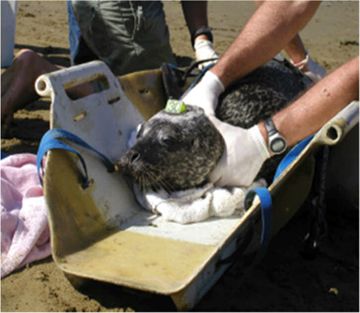
 With the marked successes of the Clean Water Act, and the resulting clean up of our sewage and industrial discharges, water quality watchdogs have been keeping their eye on the far horizon. “Rather than waiting for some new chemical to have an adverse effect, we need to be proactive about identifying the bad actors before they enter the Bay,” said the opening speaker Tom Mumley of the San Francisco Bay Regional Water Quality Control Board. But regulating contaminants of emerging concern (CECs) is a challenge: more than 1,000 new chemicals and products debut in the USA every year, and few carry any warning tags of risks to the environment (see also Tracking Next Generation Pollutants). “Once they get into the system, it’s difficult to link a chemical’s occurrence to an effect, or trace an effect back to a chemical,” said Mumley.
With the marked successes of the Clean Water Act, and the resulting clean up of our sewage and industrial discharges, water quality watchdogs have been keeping their eye on the far horizon. “Rather than waiting for some new chemical to have an adverse effect, we need to be proactive about identifying the bad actors before they enter the Bay,” said the opening speaker Tom Mumley of the San Francisco Bay Regional Water Quality Control Board. But regulating contaminants of emerging concern (CECs) is a challenge: more than 1,000 new chemicals and products debut in the USA every year, and few carry any warning tags of risks to the environment (see also Tracking Next Generation Pollutants). “Once they get into the system, it’s difficult to link a chemical’s occurrence to an effect, or trace an effect back to a chemical,” said Mumley.

Luckily, California and the Bay Area have always had a penchant for taking the bull by the horns when it comes to environmental challenges. So it’s no wonder the Bay Area’s Regional Monitoring Program began tracking CECs, and trying to figure out how to tackle them, well before the rest of the country. According to Mumley, the program has helped the region’s regulatory, scientific, and stakeholder community put together a framework to guide management and monitoring of CECs. This framework provides risk-based screening of CECs, and then applies an appropriate management response (see Powerpoints). Mumley gave an overview of major CECs that have risen to attention as a result of the screening–including chemicals found in ant sprays, flea powders and antimicrobial soaps, among others.
One group of chemicals that appeared suddenly in RMP monitoring a decade ago, and helped jumpstart the new program of CEC scrutiny, was flame retardants. Speaking in place of Rebecca Sutton, Donald Yee from the San Francisco Estuary Institute (SFEI) noted that the region’s response to the high levels of flame retardants that suddenly appeared in Bay Area seals and women offers lessons about how to be proactive in the future.
Yee started with some background about how California’s very severe flammability standards led to the widespread addition of Polybrominated diphenyl ethers (PBDEs) to plastics, foam, and textiles to keep them from catching fire. “Most of us don’t cut our furniture into pieces and then light a flame under it,” she said, describing the basic test manufacturers had to apply to meet state requirements.
The adverse effects of this anti-flammability push began to emerge a decade ago. Cal/EPA studies revealed extremely high levels of PBDEs in people and wildlife in the San Francisco Bay Area, “among the highest in the world,” said Yee. Concerned about effects on both humans and wildlife, federal and state environmental agencies pressured the major manufacturer of two of three commercial PBDE mixtures to stop production in the mid-2000s. California banned their use in 2006, and the US EPA ruled that any proposed uses of these chemicals be reviewed for safety. Production of the last commercial PBDE mixture was phased out at the end of 2013.

Yee described the RMP’s work monitoring PBDEs in the Bay over the last ten years. Researchers detected these chemicals in Bay water and sediment, as well as in Bay bivalves, fish, bird eggs, and seals. “As we discovered many times before, our chemical, technological solutions come at a price,” she said. “The good news is that we’re now seeing declining PBDE contamination in sediment and organisms, probably as a result of the state ban and federal phase-outs. The bad news is that we haven’t learned our lessons, so the main response to the phase out has been to replace PBDEs with other chemicals. It isn’t completely clear yet what these are, but the game of playing catch up feels familiar.”
Indeed, the RMP has already detected some of the alternative flame retardants replacing PBDEs in the local aquatic ecosystem. “The only way out of this loop is to really think about whether we need these chemicals in the first place, through careful consideration of how we write the standards that virtually demand their use. Fortunately, the proposed new standards are backing off the open flame test,” noted Yee.
While repelling flames could be said to benefit human safety, repelling stains has always been more of an aesthetic priority. Stain repellents added to carpets, furniture, jackets, and even popcorn bags only began to concern water quality watchdogs as a CEC in the 2000s. But they’ve been around a lot longer, explained third speaker Meg Sedlak, also from SFEI.
Manufacturers have been adding perfluorooctane sulfonate (PFOS) to soft furnishings, fire-fighting foams, metal finishing processes, and insecticides since the 1940s. “They’re great stain repellents, excellent surfactants, and good wetting agents because they repel both oil and water,” said Sedlak. They’re also highly stable. “They’re so persistent, and so widely used for some many different applications, they’ve even been turning up in relatively pristine locations like the Arctic,” she said.
In the Bay region, Sedlak was interested to find PFOS in apex predators such as seals and bird eggs as part of the RMP monitoring. “It remains elusive as to why concentrations in the South Bay are higher than the north,” she said. Sedlak showed slides of their monitoring results: eggs collected in the South Bay in 2006 and 2009 contained levels of PFOS above a threshold for impacts on offspring survival in birds (greater than 1,000 ppb). But more recent PFOS egg results in the South Bay (2012) held a surprise. “They were 70 percent lower than prior levels, and although they have declined they may still be of concern based on recent USGS studies of tree swallows,” she said.
The news has not been so rosy for seals. In collaboration with The Marine Mammal Center, the RMP analyzed harbor seal blood for PFOS and found that concentrations since 2006 exhibit similar spatial trends as for bird eggs, but no declines. “It’s a mystery why one part of the Bay has different concentrations from another, and why birds are better off now but seals not,” said Sedlak. “It may have something to do with different diets or longer half-lives of these compounds in seals.”
Sedlak spent the balance of her talk exploring different possible pathways by which these compounds might be entering the Bay, from runoff to wastewater discharges, sediment and the food web. She also discussed the possibility that precursors may be degrading to PFOS. “At present, we just don’t know the pathway by which these compounds enter the Bay food web. It’s likely all of the above,” she said.
One direct pathway for contaminants has always been the wastewater discharged by sewage treatment plants. Alarmingly, many of the medicines and birth control pills people ingest, or throw in the toilet once expired, are taking this route right into the water.
Speaker Francesca Vietor, with the San Francisco Public Utilities Commission, cited an SFEI report listing 44 different pharmaceutical compounds or metabolites detected in San Francisco Bay sediment or mussel samples. “These compounds are not natural, they’re synthesized and produced for people. Studies show these drugs disrupt fish reproductive cycles and hurt Bay ecology. And with all the antibiotics we’re adding to the environment, we’re essentially cultivating drug resistant bacteria,” said Vietor.

SFPUC has tried various things, from collaborating on collection events with Walgreens and the Bay Area Pollution Prevention Group to sending out pre-paid disposal envelopes upon request. In a pilot program funded by industry to increase the convenience of proper disposal, the PUC worked with 23 pharmacies and police stations to collect nine tons of unwanted pharmaceuticals in 2012.
“We need to educate people not to flush expired drugs or throw them in the trash, especially since sewer facilities are not designed to remove these compounds, and landfills can leach compounds into the Bay. And we need medical professionals and patients to understand the impacts of their reliance on prescription meds downstream. But education alone isn’t enough, without sustainable disposal options. We need more funding to make these options convenient and safe,” said Vietor.
Part of the funding shortfall is that it isn’t quite clear who is responsible for the problem. “If the responsibility falls to the government and the utilities, then public resources are forced to pay for solutions,” she said. And while non-profits and non-governmental organizations have broadcast the problem, they do not have the necessary resources to take on disposal. This leaves the private pharmaceutical companies that are making billions of dollars in profit each year, said Vietor: “Simply put, we need to adopt a new approach that promotes extended producer responsibility, a cradle-to-cradle design.”
2013 Pulse of San Francisco Bay
Green chemistry
Unwanted Medicines?
[toggle_box]
[toggle_item title=”PowerPoint Gallery” active=”false”]
NEXT ARTICLE: Building Resilient Baylands
By Ariel Rubissow Okamoto

Nothing could be stranger than sitting in the dark with thousands of suits and heels, watching a parade of promises to decarbonize from companies and countries large and small, reeling from the beauties of big screen rainforests and indigenous necklaces, and getting all choked up.
It was day two of the September 2018 Global Climate Action Summit in San Francisco when I felt it.
At first I wondered if I was simply starstruck. Most of us labor away trying to fix one small corner of the planet or another without seeing the likes of Harrison Ford, Al Gore, Michael Bloomberg, Van Jones, Jerry Brown – or the ministers or mayors of dozens of cities and countries – in person, on stage and at times angry enough to spit. And between these luminaries a steady stream of CEOs, corporate sustainability officers, and pension fund managers promising percentages of renewables and profits in their portfolios dedicated to the climate cause by 2020-2050.
I tried to give every speaker my full attention: the young man of Vuntut Gwichin heritage from the edge of the Yukon’s Arctic National Wildlife Refuge who pleaded with us not to enter his sacred lands with our drills and dependencies; all the women – swathed in bright patterns and head-scarfs – who kept punching their hearts. “My uncle in Uganda would take 129 years to emit the same amount of carbon as an American would in one year,” said Oxfam’s Winnie Byanyima.
“Our janitors are shutting off the lights you leave on,” said Aida Cardenas, speaking about the frontline workers she trains, mostly immigrants, who are excited to be part of climate change solutions in their new country.
The men on the stage, strutting about in feathers and pinstripes, spoke of hopes and dreams, money and power. “The notion that you can either do good or do well is a myth we have to collectively bust,” said New Jersey Governor Phil Murphy whose state is investing heavily in offshore wind farms.
“Climate change isn’t just about risks, it’s about opportunities,” said Blackrock sustainable investment manager Brian Deese.
But it wasn’t all these fine speeches that started the butterflies. Halfway through the second day of testimonials, it was a slight white-haired woman wrapped in an azure pashmina that pricked my tears. One minute she was on the silver screen with Alec Baldwin and the next she taking a seat on stage. She talked about trees. How trees can solve 30% of our carbon reduction problem. How we have to stop whacking them back in the Amazon and start planting them everywhere else. I couldn’t help thinking of Dr. Seuss and his truffala trees. Jane Goodall, over 80, is as fierce as my Lorax. Or my daughter’s Avatar.
Analyzing my take home feeling from the event I realized it wasn’t the usual fear – killer storms, tidal waves, no food for my kids to eat on a half-baked planet – nor a newfound sense of hope – I’ve always thought nature will get along just fine without us. What I felt was relief. People were actually doing something. Doing a lot. And there was so much more we could do.
As we all pumped fists in the dark, as the presentations went on and on and on because so many people and businesses and countries wanted to STEP UP, I realized how swayed I had let myself be by the doomsday news mill.
“We must be like the river, “ said a boy from Bangladesh named Risalat Khan, who had noticed our Sierra watersheds from the plane. “We must cut through the mountain of obstacles. Let’s be the river!”
Or as Harrison Ford less poetically put it: “Let’s turn off our phones and roll up our sleeves and kick this monster’s ass.”
by Isaac Pearlman
Since California’s last state-led climate change assessment in 2012, the Golden State has experienced a litany of natural disasters. This includes four years of severe drought from 2012 to 2016, an almost non-existent Sierra Nevada snowpack in 2014-2015 costing $2.1 billion in economic losses, widespread Bay Area flooding from winter 2017 storms, and extremely large and damaging wildfires culminating with this year’s Mendocino Complex fire achieving the dubious distinction of the largest in state history. California’s most recent climate assessment, released August 27th, predicts that for the state and the Bay Area, we can expect even more in the future.
The California state government first began assessing climate impacts formally in 2006, due to an executive order by Governor Schwarzenegger. California’s latest iteration and its fourth overall, includes a dizzying array of 44 technical reports; three topical studies on climate justice, tribal and indigenous communities, and the coast and ocean; as well as nine region-specific analyses.
 The results are alarming for our state’s future: an estimated four to five feet of sea level rise and loss of one to two-thirds of Southern California beaches by 2100, a 50 percent increase in wildfires over 25,000 acres, stronger and longer heat waves, and infrastructure like airports, wastewater treatment plants, rail and roadways increasingly likely to suffer flooding.
The results are alarming for our state’s future: an estimated four to five feet of sea level rise and loss of one to two-thirds of Southern California beaches by 2100, a 50 percent increase in wildfires over 25,000 acres, stronger and longer heat waves, and infrastructure like airports, wastewater treatment plants, rail and roadways increasingly likely to suffer flooding.
For the first time, California’s latest assessment dives into climate consequences on a regional level. Academics representing nine California regions spearheaded research and summarized the best available science on the variable heat, rain, flooding and extreme event consequences for their areas. For example, the highest local rate of sea level rise in the state is at the rapidly subsiding Humboldt Bay. In San Diego county, the most biodiverse in all of California, preserving its many fragile and endangered species is an urgent priority. Francesca Hopkins from UC Riverside found that the highest rate of childhood asthma in the state isn’t an urban smog-filled city but in the Imperial Valley, where toxic dust from Salton Sea disaster chokes communities – and will only become worse as higher temperatures and less water due to climate change dry and brittle the area.
According to the Bay Area Regional Report, since 1950 the Bay Area has already increased in temperature by 1.7 degrees Fahrenheit and local sea level is eight inches higher than it was one hundred years ago. Future climate will render the Bay Area less suitable for our evergreen redwood and fir forests, and more favorable for tolerant chaparral shrub land. The region’s seven million people and $750 billion economy (almost one-third of California’s total) is predicted to be increasingly beset by more “boom and bust” irregular wet and very dry years, punctuated by increasingly intense and damaging storms.
Unsurprisingly, according to the report the Bay Area’s intensifying housing and equity problems have a multiplier affect with climate change. As Bay Area housing spreads further north, south, and inland the result is higher transportation and energy needs for those with the fewest resources available to afford them; and acute disparity in climate vulnerability across Bay Area communities and populations.
“All Californians will likely endure more illness and be at greater risk of early death because of climate change,” bluntly states the statewide summary brochure for California’s climate assessment. “[However] vulnerable populations that already experience the greatest adverse health impacts will be disproportionately affected.”
“We’re much better at being reactive to a disaster than planning ahead,” said UC Berkeley professor and contributing author David Ackerly at a California Adaptation Forum panel in Sacramento on August 27th. “And it is vulnerable communities that suffer from those disasters. How much human suffering has to happen before it triggers the next round of activity?”
The assessment’s data is publicly available online at “Cal-adapt,” where Californians can explore projected impacts for their neighborhoods, towns, and regions.
